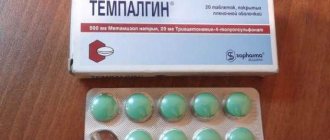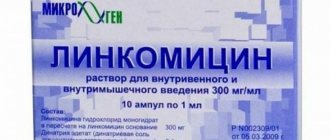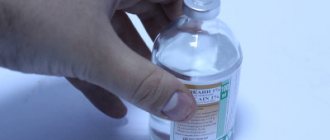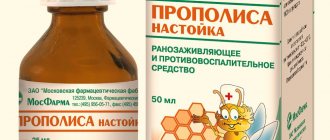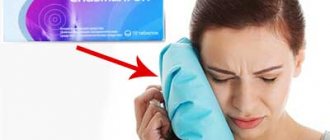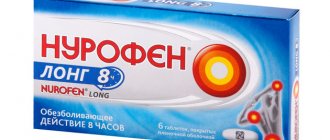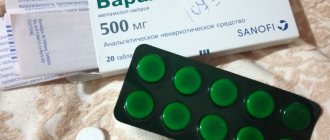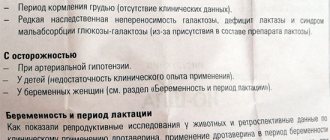Anti-inflammatory pills
Inflammatory processes in the oral cavity are characterized by a unique clinical picture and depend on the localization of the focal infection, the depth of tissue damage, etc. As a rule, they are accompanied by the formation of a certain amount of purulent-necrotic discharge and fibrinous plaque.
Therefore, local treatment should be aimed at eliminating pathogenic microflora and clearing viable tissue from areas of necrosis to stimulate epithelization processes. In recent years, dentists have begun to widely use dimethyl sulfoxide (DMSO) to treat a number of inflammatory processes in the oral cavity, claiming that when used topically, pain quickly disappears and swelling decreases.
Bacteriological studies have shown that a solution containing no more than 30% DMSO has a bacteriostatic effect, and a solution containing 35% of the drug or more has a bacteriocidal effect (A.P. Lykova, 1966).
Considering the anti-inflammatory properties of DMSO and its ability to diffuse deeply into tissues, we used the drug for local therapy for inflammatory processes in the oral cavity. The drug was used both independently and in mixture with antibiotics or sulfonamides.
There were 90 patients under our supervision. Of these, 71 had odontogenic periostitis, 5 had phlegmon, and 14 had alveolitis. Treatment was carried out according to the following method developed by us. In acute and aggravated odontogenic processes, an outflow of pus was created through the tooth canal or by cutting the soft tissue along the transitional fold.
Before incision of soft tissues, the mouth was rinsed abundantly with antiseptic solutions. The purulent cavity was washed with furatsilin, then a gauze turunda soaked in a 40% DMSO solution was inserted. The procedure lasted 20 minutes. and was carried out once a day. Usually, after 2-3 treatment sessions, patients felt significantly better, inflammation and swelling decreased.
Long-term observations (2.5 years) of patients treated with DMSO indicate that this drug does not have a negative effect on dental tissues and mucous membranes of the oral cavity.
DMSO may be recommended for the treatment of inflammatory diseases of the oral cavity.
Anti-inflammatory drugs for flux have a strong analgesic effect, relieve swelling and reduce inflammation. Some of the medications used can relieve high fever, which sometimes accompanies the symptoms of periostitis.
Nimesil
Flux tablets with a pronounced analgesic effect actively eliminate inflammation at all stages of the disease. The daily dose of the drug is 200 mg (1 tablet of 100 mg twice a day). The duration of treatment depends on the clinical picture of periostitis and the need for treatment of toothache.
Diazolin
A drug for flux from the group of antiallergic drugs. It has a strong anti-edematous effect, reduces the production of biologically active inflammatory substances at the site of abscess development. Diazolin is taken depending on the severity of swelling of the gum and cheek tissues, 1 tablet (100 mg) 1-3 times a day until the condition improves.
Diclofenac
An anti-inflammatory drug that has a powerful anti-inflammatory effect, significantly reduces toothache. To eliminate pain, use 25-50 mg 1-2 times a day.
Apple cider vinegar, chlorhexidine, dimexide, streptocide, erythromycin, syntomycin and bodyaga for acne
acne on face photo
Acne on the face spoils the mood so much and interferes with the implementation of plans that many are ready to shell out a tidy sum for salon treatments just to forget about such problems.
But even such measures are not fully guaranteed.
Meanwhile, there are effective remedies that are quite inexpensive. But you will have to carry out the procedures yourself.
Bodyagu for getting rid of acne
This is the simplest of the genus of coelenterate sponges, living in freshwater environments. Colonies of sponges are dried and ground into powder, subsequently used for cosmetic purposes. The finished product has a gray-green color and an unpleasant odor.
But the bodyaga completely compensates for this with its miraculous results:
- removes the stratum corneum of the skin;
- increases blood circulation;
- cleanses pores;
- heals wounds, resolves hematomas.
acne badya photo
Bodyaga relieves acne and marks left after the inflammatory process. To do this, you can purchase a gel, ointment or dry mixture at the pharmacy.
In the latter case, the product is prepared independently, but provides an increased effect.
Important!
The medicine should not be used during an exacerbation.
Dry bodyaga is diluted with hydrogen peroxide to a paste-like state and applied to the face in a thin layer or spotwise. After 15 minutes, the mask must be washed off. You can't rub it because the skin will get severely irritated.
Bodyaga powder can be mixed with white or green cosmetic clay in a ratio of 1:3 and diluted with a decoction of herbs. To be effective, the applied mask should be covered with a damp, hot cotton cloth.
Contraindications to the use of bodyagi are sensitive skin. You should not carry out procedures during active solar radiation. A prerequisite is the use of creams with a high SPF.
Important!
After the procedure, redness of the skin is possible, which can last up to two days. This must be taken into account before trial application.
Apple Cider Vinegar for External and Internal Acne Attack
This is a natural vitamin product. Bacteria love an acidic environment, and apple cider vinegar neutralizes it, creating unfavorable conditions for acne. Do not use regular apple cider vinegar for acne. It should be diluted with purified water.
apple cider vinegar for acne photo
When these components are combined in a ratio of 1:8, an excellent tonic is obtained, which can be stored in the refrigerator for 4-5 days. Before going to bed, you should wipe your face and not wash your face after the procedure.
Instead of water, you can use herbal decoctions (queen, celandine, chamomile) and green tea. Apple cider vinegar helps against acne when used in a mask based on cosmetic clay. To the latter add 1 teaspoon of vinegar and 3 times more water or herbal decoction. The mask remains on the face for 20 minutes.
Apple cider vinegar, used as a drink, has a general strengthening effect on the body. Its use gets rid of acne and causes a healthy glow.
Add 2 teaspoons of vinegar and 1 teaspoon of honey to a glass of water. The drink should be taken for a month.
Contraindications are diseases of the stomach, liver, and duodenum.
Acne treatment with chlorhexidine
chlorhexidine for acne photo
This is an antibacterial solution that, penetrating the skin, kills germs and makes the environment unfavorable for their development and reproduction.
Chlorhexidine is used for acne in combination with some other remedy. It should only be used point-wise and as needed.
The product should be applied to the skin around the acne before squeezing (if this is an extreme case) and after.
To treat a rash, pimples are treated with a solution, and after 10 minutes an ointment is applied.
At a concentration of 0.01% the product is antimicrobial, at 0.05% it is antiviral. It penetrates into the inner layers of the epidermis and does not lose its properties for a long time. Chlorhexidine does not damage the skin, but you should not overdo it.
Dimexide as a booster for acne medications
The medication is not an antibiotic, but enhances the effect of other drugs due to its ability to penetrate deep into the skin cells. This is an antimicrobial and anti-inflammatory solution, so it has become a worthy assistant in the fight against acne.
A good preventive measure is a solution prepared for wiping the face. To do this, 2 tablets of erythromycin are dissolved in dimexide. The product is used for both treatment and prevention.
To enhance the effect of any masks, you need to add the medicine to the mixture in a small amount (about 1:10).
Dimexide helps well against acne as part of a mask with cosmetic oils. In this case, the components are combined in equal quantities. For spot treatment of acne, the solution is diluted with water in a ratio of 1:5.
Dimexide helps get rid of acne, but it also has negative sides: it dries the skin very much, can irritate the mucous membranes of the eyes and nose, cause itching and burns. It should not be used without prior testing.
Contraindications for use are diseases of the heart, kidneys, liver, pregnancy and lactation.
Acne remedies with streptocide
Streptocide is available in the form of powder, tablets, and ointment. The latter is applied twice a day pointwise, but is used for no longer than 2 weeks.
streptocide for acne photo
An excellent remedy is streptocide for acne in masks. To do this, the tablets must be ground with aloe juice until they form a paste.
Another option: mix crumbly streptocide (crushed tablets) and baby powder in equal proportions, dilute the powder with a 3% solution of hydrogen peroxide. Make masks in the evening.
To prepare mash, you can crush several tablets and add them to calendula tincture or salicylic alcohol. Before treating your face, the product should be shaken well.
Antibiotics for acne
- Erythromycin
This is an antiseptic and antibacterial agent, therefore it effectively fights acne. Stops the process of reproduction of pathogenic microorganisms, accelerates skin regeneration. Many lotions and gels contain erythromycin. One of them is “Zinerit”. For more severe acne, tablets are taken orally (only as prescribed by a doctor). In other cases, erythromycin for acne is used in the form of an ointment. You can use the product for no longer than 14 days (teenagers must have a doctor’s prescription). Longer use may disrupt the intestinal microflora. Contraindications include liver disease, kidney disease, pregnancy and lactation. - Synthomycin
Syntomycin ointment fights bacteria and viruses. Its basis is the antibiotic chloramphenicol. Syntomycin for acne photo Novocaine, which is included in the composition, has an analgesic effect, castor oil prevents overdrying of the epidermis. The product lightens the skin, helping to get rid of dark spots remaining after acne. The ointment can cope with almost any infection that affects the skin. Applied precisely. Syntomycin for acne is used only independently.
You cannot use other means at the same time, because you may get irritated. Do not apply the ointment during pregnancy and lactation, or with liver and kidney diseases.
Whatever remedy is chosen, it will not be able to completely cope with the problem if you do not pay attention to your diet.
During treatment, you should avoid fatty meats and fish, hot seasonings, sweet carbonated water, and fast food products. The body will also be very grateful for getting rid of bad habits. The reward will be glowing skin.
Source: https://caringmother.ru/78-bodyaga-yablochnyy-uksus-hlorgeksidin-dimeksid-streptocid-eritromicin-sintomicin-ot-pryschey-kakoe-iz-etih-sredstv-samoe-deystvennoe.-pravila-ispolzovaniya-i -kakie-est-propivopokazaniya.html
Dimexide, description, use at home
A synthetic drug that is used for external use for pain in muscles and joints. Has an analgesic, anti-inflammatory, antibacterial effect. Used in dermatology, prescribed to patients for joint problems, to relieve muscle pain. The basis of the medicine is the active component dimethyl sulfoxide, of which almost 99 percent is in the drug.
Dimexide is used mainly in dermatology to treat skin diseases, as well as to eliminate joint and muscle pain. It is often applied to the problem areas. Penetrating through the upper layers of the epidermis, it is able to quickly block pain and other unpleasant sensations directly at the sites of occurrence.
On the modern pharmacological market, the drug is presented in various forms:
- solution (concentrated liquid);
- gel;
- pills;
- ointment;
- candles with the addition of propolis.
The drug in any form is used for external, vaginal, rectal use. Enriched with propolis, it enhances the effect of both components. The medicine quickly penetrates the blood through the mucous membrane or through the upper layer of the epidermis, which allows it to almost instantly affect problem areas, dissolve hormones, antibiotics, salts and organic compounds of complex medicinal complexes of plant origin. To put it simply, treatment with dimexide accelerates the effect of other medications.
The drug has a wide range of applications. This is confirmed by the dimexide instructions supplied by the manufacturer. Among the main diseases are:
- sepsis;
- purulent skin diseases;
- scleroderma;
- burns;
- eczema;
- trophic ulcers;
- thrombophlebitis;
- haemorrhoids;
- furunculosis;
- wounds, cuts with the formation of pus;
- sprains;
- bruises;
- muscle pain.
Important! The instructions supplied by the manufacturer are intended for professional medical personnel. You should not prescribe the drug yourself.
The drug dimexide, instructions for use confirm this fact; recently dimexide has been actively used in dentistry and plastic surgery. This contributes to faster implant healing. Moreover, in cosmetology the medicine is used as a component that can activate hair follicles.
But even in cosmetology, you should use the solution with caution when making hair masks. For example, a hair mask must be prepared only before direct application; you cannot store the product you prepared yourself. This, at best, will have no effect.
Rules of application
Indications for use of the drug indicate that the medicine is used not only for external use. Although a few years ago, its ingestion was strictly prohibited. But today the situation is different and the range of use of the drug has expanded significantly. These are tablets for internal use, vaginal and rectal suppositories, and even solutions for injections.
Most often, patients use a solution designed for external use. However, the composition of the drug can cause allergic reactions and burns. Therefore, it should not be used before consulting a doctor, especially for children. The fact is that pediatricians often recommend a solution to relieve pain during teething in children under one year old. Using it yourself in such situations is extremely imprudent.
The drug can be used as an individual and auxiliary remedy for the treatment of various diseases. This helps speed up the healing process of wounds, increases the activity of antibacterial drugs, even if the bacteria are immune, and increases the body's resistance. But we must not forget that dimexide has contraindications.
We suggest you read about the first teeth in infants: how to relieve pain
The drug has been actively used in medicine and cosmetology for thirty years. During this time, there are practically no negative reviews. The only exception is individual intolerance to the components.
The drug dimexide is not considered dangerous, but the drug still has contraindications and this is due to individual intolerance and the properties of its effect on the body. It is also not recommended for use by people with the following diseases:
- atherosclerosis;
- cataract;
- glaucoma;
- angina pectoris;
- heart attack;
- hypersensitivity to the main components.
The drug should be used with special care by children, pregnant women and breastfeeding women. The drug can be used for dental treatment, especially in infancy, only on the recommendation of the attending physician. The components of the medicine may irritate the gastrointestinal tract if ingested, causing diarrhea, nausea, and vomiting. The attached manufacturer's note warns about this.
How to use
It would not be superfluous to immediately recall that the information presented here cannot be taken as a basis for the treatment of a particular disease. This is done only for the purpose of familiarization to those people who are prescribed the drug for oral or external use. The drug can be used in various situations.
Specific dosages cannot be used alone. Too serious consequences are possible with self-medication.
- Treatment of affected skin areas. Compresses with the product are used. The course of treatment is about 15 days.
- Treatment of trophic ulcers. Apply a compress with 40% of the composition of the product. It is not recommended to apply such compresses to open ulcers more than 2 or 3 times a week.
- Dimexide has indications as an anesthetic; it is used for diseases of the teeth and gums in the form of rinses with an aqueous solution. To relieve pain in muscles and joints, use a pure 25% solution in the form of compresses.
- Summer is insidious with its insects, so the drug can be used to eliminate the consequences of bee and mosquito bites. Use a 20-30% solution.
Ointments and gels can often be used by parents if the child complains of various pains. Their percentage composition is approximately the same as the liquid composition. But this consistency is more convenient to use to treat children's problems. The medicine is applied to the sore spot, after which a warming bandage is applied.
In a dry place protected from light
Shelf life: 2 years.
Ceftriaxone chlorhexidine dimexide compress
A compress with dimexide and dexamethasone is often used to treat pathologies of the musculoskeletal system and infectious skin damage.
Action of dimexide
Useful properties of dimexide:
- The product has pronounced anti-inflammatory and disinfecting properties.
- Stimulates regeneration in damaged tissues.
- Affects blood circulation, preventing the development of blood clots.
- Eliminates tension and pain in joints.
- Normalizes the body's metabolic processes.
- The product can act as a conductor, taking with it medications dissolved with it. Dimexide penetrates the skin to a depth of 5 cm.
Dexamethasone refers to a hormonal agent for systemic or local use. Fluorinated homolog of hydrocortisone.
Has the following actions:
- anti-shock;
- immunosuppressive;
- glucocorticoid;
- antiallergic;
- anti-inflammatory.
You can take the substances at the same time. The combined effect of compresses with dexamethasone and dimexide is to quickly relieve pain and inflammation in the affected area.
Indications for simultaneous use
Joint lotions are shown:
- For symptomatic treatment of musculoskeletal diseases:
- arthrosis of the knee joint;
- arthritis;
- radiculitis;
- gout;
- pinched trigeminal nerve.
- After injuries received during sports.
Often, novocaine, which is an anesthetic, is added to these medications.
- individual intolerance to the composition;
- diseases of the cardiovascular system;
- kidney and liver diseases;
- age group (children and elderly);
- cataract;
- During pregnancy and breastfeeding.
For good results, when mixing substances, the recommended proportions should be observed. Dimexide 50% in the amount of 1 tbsp should be diluted with 5 tbsp. water and 1 ampoule of dexamethasone. Novocaine 2% can be added to the resulting solution as an anesthetic.
Gauze cloth should be folded into 3-4 layers and moistened in the prepared solution. The lotions are applied to the skin for 30 minutes. The top of the gauze is covered with cellophane and secured with cotton material. The course of therapy lasts up to 2-3 weeks. Only a doctor can prescribe the exact course of therapy.
Recommendations for using the compress:
- The process should be performed with rubber gloves. This will protect your hand skin from burns and irritation.
- Do not rub the solution into the skin.
- Use only gauze. Dimexide, by absorbing dye from fabric, can cause skin irritation.
- Manipulations are performed only with fresh solution.
- Do not increase the duration of therapy.
- To increase the effect, the painful joint can be treated with anti-inflammatory ointment before the compress.
Side effects
Possible side effects:
To avoid adverse reactions, an allergy test should be performed before applying gauze. If intolerance to the components of the drug is detected, its use should be discontinued.
Reviews
Natalya Aleksandrovna, 45 years old, St. Petersburg: “The compress helped with bursitis of the knee joint. The course lasted 14 days. The pain in the knee has decreased, and the condition has returned to normal.”
Nikolai Petrov, 49 years old, Pravdinsk: “The diagnosis is arthrosis of the knee. I did the lotions for 3 weeks at night. The pain has gone, the swelling has subsided.”
Anna Fedorovna, 55 years old, Novosibirsk: “The doctor diagnosed a disease - arthrosis of the joint. There was severe pain and swelling. After a course of lotions, the pain subsided and the swelling completely disappeared. My husband used compresses to treat gout. It helped."
Source my-pochki.ru
Chlorhexidine is a drug that exhibits antiseptic and bactericidal properties, used to disinfect wounds and destroy pathogenic bacteria. Many patients are interested in knowing whether it is possible to use a compress with Dimexide and Chlorhexine.
The main active ingredient of Dimexide is dimethyl sulfoxide, which has analgesic, antimicrobial, anti-inflammatory and antiseptic effects. Due to its ability to penetrate through intact tissues, the drug increases their permeability to other medicinal substances.
Application
Both drugs are successfully used to treat inflammatory processes and damage to the skin, including purulent ones. The combination of Dimexide and Chlorhexidine increases the bactericidal and antiseptic effect on wound surfaces, and also quite effectively relieves inflammation.
Most often, to treat skin damage, doctors advise making a compress of Dimexide with Chlorhexidine . Such procedures are carried out not only in case of damage to the skin. Very often, a combination of these two drugs is successfully used to treat inflamed lymph nodes.
Judging by the reviews of doctors and patients, the inflammation goes away very quickly, literally on the first day after a properly applied compress, the size of the inflamed lymph node is reduced by almost half. This is due to the bactericidal, anti-inflammatory and anti-edematous properties of the drugs.
Dimexide can be diluted in Chlorhexidine in different proportions. Often several other medications are used for compresses. One of these drugs is novocaine.
The proportions of Dimexide and Chlorhexidine in the compress can be as follows:
- For the treatment of inflamed lymph nodes, a ratio of 1:4 is most often used (one part of Dimexide and four parts of Chlorhexedine);
- To treat skin damage, a combination of 1:3 - 1:5 is most often used (where 1 is one part of Dimexide, the rest is Chlorhexidine);
- For the treatment of facial skin lesions, drugs are diluted in a concentration of 1:10 - 1:5;
- To use compresses in pediatrics, a maximum dilution of the product is required, 1:8 - 1:10;
- When treating inflammatory processes localized in the joints, a concentration of 5:3:3 is used (5 parts Dimexide, 3 parts Chlorhexidine, 3 parts novocaine). You can add one ampoule of hydrocortisone to the finished product.
Features of preparing the solution and carrying out the procedure
Is it necessary to dilute Dimexide for a compress? Yes, of course, the use of Dimexide in its pure form can lead to allergic reactions and burns.
If the skin is hypersensitive, the percentage of Dimexide in the solution should be reduced.
The dressing material on which the medicine will be applied must be sterile and colorless (white), since fabric dyes may react with the active substances.
The time of the procedure must exactly correspond to the doctor’s prescription; most often the compress is carried out for about thirty minutes.
To treat joint inflammation, you can combine compresses with anti-inflammatory ointments, or add anti-inflammatory substances, including diclofenac, to the solution.
If it is necessary to apply a compress to a child, the concentration of Dimexide in the solution should be reduced.
If the possibility of making a compress is excluded, you can treat the wound with Chlorhexidine or Dimexide, which will help disinfect the damage.
Sources:
Vidal : https://www.vidal.ru/drugs/chlorhexidine__33843 GRLS : https://grls.rosminzdrav.ru/Grls_View_v2.aspx?routingGu >
Found a mistake? Select it and press Ctrl + Enter
Source pillsman.org
How to restore lifeless hair at home.
What to do if your hair becomes lifeless, brittle and dry
Sore throat: laryngitis, tonsillitis, pharyngitis and 6 other reasons.
Sore throat: symptoms and treatment. When can you eat ice cream and not suck on lollipops?
Why don't medications help? First aid kit, medicines
.
Use antibiotics Antibiotic Inadmissible combinations Penicillins (penicillin, ampicillin, oxacillin, methicillin) Amino acids, adrenaline, ascorbic acid, B vitamins, heparin, hydrocortisone, mesaton, aminophylline, hydrogen peroxide, potassium permanganate, alcohols, enzymes, ephedrine, tetracyclines Levomy tetracyclines cetin, erythromycin, aminophylline, sulfonamides, hydrocortisone, heparin Gentamicin, amikacin Penicillins, tetracyclines, aminophylline, heparin Lincomycin Kanamycin, penicillins, cephalosporins, erythromycin Cephalosporins Lincomycin, chloramphenicol, aminophylline, barbiturates, hydrocortisone, sulfonamides Levomycetin Penicillium ny, tetracyclines, cepharosporins, erythromycin, ascorbic acid.
Do you prescribe Dioxidin in the nose for children? Child from 1 to 3
ENT prescribed Nazivin for the child, then dioxidin. He says it's a classic. a scheme that has been tested for years, but now for some reason dioxidin is prohibited for use by children under 14 years of age.
Now I've been scouring the Internet, and they write in the annotation for the drug (although they mean intravenously) that it is toxic, mutogenic and other horror stories. Contraindications: children's age. Our diagnosis is a viral-bacterial infection. High temp 39 for 5 days now.
Among other things, they prescribed Augmentin. Actually a question, if anyone.
Medicinal issue. How to treat a nursing mother?
.
Vitamins, vitamin-mineral complexes, minerals. Used during breastfeeding. Side effects - allergic reactions. It is advisable to choose those drugs that do not pass into breast milk well. Hormones (prednisolone, dexamethasone, hydrocortisone). They are used for autoimmune diseases (rheumatoid arthritis, systemic connective tissue diseases, autoimmune hepatitis, etc., for some blood diseases, for adrenal insufficiency, etc.). Usually not contraindicated during breastfeeding.
However, safety for long-term use has not been proven, therefore, if treatment is necessary for more than 10 days, the issue of continuing breastfeeding is decided individually. If a nursing woman needs it.
Source conf.7ya.ru
Source: https://med-group.ru/ceftriakson-hlorgeksidin-dimeksid-kompress/
How to rinse your mouth with flux
Mouth rinse for flux
Rinse solutions in the initial stages of the disease can have an anti-inflammatory effect and prevent the development of an abscess. If, nevertheless, the dentist had to open the source of suppuration, he will definitely tell you how to rinse the flux in order to avoid further spread of inflammation and quickly eliminate the symptoms.
Regular baking soda is the simplest and most reliable remedy for periostitis. It will quickly eliminate swelling, relieve pain for a long time and stop the inflammatory process. To prepare a solution for rinsing from flux, you need to dissolve a full teaspoon of soda in 200 ml of cooled boiled water.
Rotokan
The basis of the drug is an alcoholic infusion of medicinal herbs: calendula, chamomile and yarrow. Rinsing the mouth with flux with a rotokan solution has an antiseptic effect, reduces painful manifestations, and relieves inflammation. Dissolve 5 ml of the product (1 teaspoon) in a glass of warm water and rinse every 2-3 hours until the pain subsides. In the stage of subsidence of the inflammatory process, the procedure is carried out 3-4 times a day.
Malavit
The drug contains natural extracts of medicinal herbs, silver and copper ions, due to which Malavit has an antibacterial effect, relieves even severe tissue swelling, relieves pain and prevents the spread of infection. 5-10 drops of the medicine should be dissolved in warm, but not boiled water.
Chlorhexidine
The drug has a detrimental effect on almost all groups of pathogenic microorganisms. When applied topically, it has a pronounced anti-inflammatory and wound-healing effect. Mouth rinsing with flux is carried out with a 0.5% aqueous solution of chlorhexidine 4 times a day until the clinical manifestations subside.
Betadine
Thanks to the active iodine included in the drug, betadine perfectly fights pathogenic bacteria, eliminates inflammation, prevents the formation of a purulent focus and promotes the rapid healing of damaged tissues. To prepare a solution for rinsing the mouth, a teaspoon of 1% of the drug is dissolved in a quarter glass of warm water and rinsed 4 times a day until symptoms relieve.
Furacilin
Flux agent with a strong antibacterial effect. To rinse, dissolve 1 tablet of furatsilin in a glass of boiling water. After the solution has cooled, rinse your mouth every 2-3 hours until the pain subsides and the swelling on the cheek subsides.
Alveolitis as a sign of edema
This disease is the main post-resection complication. It provokes swelling of the soft tissues of the face. Alveolitis develops gradually, with infection of the injured tissues of the socket and necrosis of the blood clot.
Causes of alveolitis:
- Carious bacteria and plaque particles penetrated the hole and caused infection.
- After removal, a fragment of the chewing organ remained.
- Bleeding of the socket tissue prevents the formation of a clot.
- The blood clot festers.
- Oral hygiene is not maintained.
- Immunity is weakened.
- The removal procedure occurs during exacerbation of periodontitis.
Alveolitis can be easily identified using symptoms and visual inspection of the socket. Symptoms:
- The hole is empty, without a blood clot, a yellowish coating, there are food remains in it, a rotting blood clot. The gums are bright red, swollen, painful on palpation. Sometimes exposed bone tissue is visible.
- Sharp or mild pain in the socket. Headache. Strong analgesics relieve them, but they do not treat inflammation.
- A rotting blood clot is accompanied by an unpleasant rotting smell. Pus provokes intoxication of the body, poor health, fatigue, and increased body temperature.
- More often, alveolitis is not accompanied by swelling of the soft tissues of the face: pus flows through the empty socket. But with acute manifestations of suppuration of a blood clot, the gums and soft tissues of the face swell, hurt, and the temperature rises.
Antibiotics
Talk to your doctor before using antibiotics
The use of antibiotics is an important point in successful flux therapy. At an early stage, these medications can stop the spread of infection and prevent the appearance of an abscess. At later stages, when a purulent focus has already formed, antibacterial drugs are prescribed after opening it to prevent complications and speedy recovery.
Antibiotics for gumboils should not be taken independently. Only a dentist can give a recommendation which drug should be taken and in what dosage. This will depend on the patient’s age and weight, his condition and the presence of drug intolerance.
The most commonly used antibacterial agents for flux:
- Lincomycin
- Amoxicillin
- Tsiprolet
- Amoxiclav
- Doxycycline
- Ciprofloxacin
- Trichopolum
- Flemoxin solutab
- Biseptol
- Levomycetin
We suggest you read: How much does it cost to insert one tooth, a crown per tooth?
Alpha Creation
Periodontal disease is the leading cause of tooth loss in middle age and older adults. This is a disease of the gums and periodontium, as well as the bones that support the teeth. In general, it is caused by poor oral hygiene and poor diet, which often includes excessive amounts of refined sugar. All this encourages the growth of bacteria. Regular cleaning with dimexide greatly reduces the growth of bacteria.
Disease of the gums and supporting tissues goes through a process in the early stages called gingivitis (inflammation of the gums). This is an inflammatory disease of the gums. Bacteria feed on food particles left on the gums, causing the formation of tartar, which consists of thousands of living bacteria.
At this stage, gingivitis turns into periodontitis. Progressive infection and even greater inflammation are observed. Teeth become weak and may fall out. If the process has not progressed too far, dentists may still be able to save some weak teeth, especially if dimexide is used.
Bacteria need food to survive. They live on food particles left in the mouth. The bacteria also remove their waste. They leave their feces on their teeth and gums. This is what causes bad breath in a person with gum disease.
The bacteria cause the production of plaque, which eventually dies off. Dead plaque hardens and calcifies and is then called tartar. When tartar builds up around a tooth, it separates the gum from the tooth. When this happens, a free space appears in which even more food particles collect, resulting in even more bacteria.
Since 1960, dimexide has been successfully used in the treatment of teeth and gum problems. A formal study in Poland included 32 patients with periodontal disease (18). These patients had inflammation and bleeding of the gums. In 13 patients, the disease included only bleeding and gum swelling. In the remaining 19, the infection spread deep into the gums, sometimes even into the bone, and tooth loss was observed.
First, the teeth were cleaned and bacteria was removed as much as possible. Then the patients were treated with a compress containing 30 percent dimexide for 10 minutes every other day, for a total of 7 to 10 treatments.
All patients with mildly advanced disease experienced enormous improvements. In all patients, the pain went away, bleeding was greatly reduced, and loose teeth became stronger. All patients with deep infection had less inflammation and less pain. Severely loose teeth were not fixed in any patient.
In the early stages, treatment is much easier and the results are much better. Teeth that are not too loose can become stronger. As far as the author of the book knows, very loose teeth are not fixed even when treated with dimexide.
Many people use a 50 percent dimexide solution to rinse their mouth. Others brush their teeth with dimexide. The author of the book has been brushing his teeth with dimexide for more than 40 years with good results. His teeth and gums have had far fewer problems since he started using dimexide regularly. Some people use dimexide to relieve tooth pain until they can visit the dentist.
Some dentists regularly use dimexide in their dental practice to treat problems associated with pain, infections and tumors. Dimexide can be used alone or in combination with antibiotics and other medications. It is especially useful in treating gums after tooth extraction. Dimexide reduces swelling and pain, and also reduces the risk of infection. Dimexide can be applied to the outside of the cheek or jaw near the site where the tooth is extracted.
One New York City dentist uses dimexide to reduce radiation damage from dental X-rays. Before starting the procedure, he applies dimexide to the area where the x-ray will be taken. Of course, it also uses regular lead protection.
Regular use of dimexide by the dentist and his patient can prevent the development of many dental problems. Dimexide can be used to relieve any problem. Teeth should last a lifetime. With proper use of dimexide, the patient is much more likely to live a long life with healthy teeth and gums.
Content
Why is my cheek swollen after tooth extraction?
The following factors can cause swelling:
- complex tooth extraction with significant trauma to soft tissues;
- tooth root fracture;
- the presence of fragments in the wound that injure tissue;
- defective removal;
- removal due to an acute inflammatory process;
- improper antiseptic treatment of the wound;
- use of poorly sterilized instruments;
- allergic reaction to medications used;
- root cyst;
- wound infection;
- the occurrence of alveolitis.
Many patients in dental clinics are worried about why their cheek is swollen after tooth extraction and whether they need to see a doctor about this problem. This symptom may occur due to tissue damage during medical procedures. There are many reasons for complications; it is impossible to independently determine why they develop and what to do.
After any operation there will be discomfort and pain. After a difficult removal, when the doctor had to damage the bone, gum, mucous membrane, swelling is a normal reaction. If during the postoperative period the pain increases, there is pus in the wound, and it becomes unpleasant, you need to consult a doctor.
Inflammation of the socket or gum is manifested by redness, sharp pain, and slight swelling. Most often, this indicates infection of the wound, which happens if the doctor’s recommendations are not followed in the postoperative period.
Unpleasant symptoms occur when the body reacts acutely to an intervention, because during the operation the doctor can damage tissue. Pathological swelling occurs when infection and pathogenic microorganisms enter the wound due to improper actions of the dentist or patient.
It should be noted that complications more often occur in people with chronic diseases, with weakened immunity, during illness, or acute respiratory viral infections. Therefore, it is recommended to schedule a visit to the doctor after the disease has resolved. Tooth extraction should not be performed after vaccination, during menstruation, or when suffering from acute viral and bacterial infections.
Ointments and gels
Local use of ointments for periostitis contributes to the rapid extinction of inflammatory processes, faster healing of damaged tissues, and effective elimination of pain.
Vishnevsky ointment
With flux, Vishnevsky ointment can stop the development of the purulent process, quickly eliminate tissue swelling and relieve toothache. The xeroform included in the drug has an antibacterial effect, birch tar increases blood flow at the site of injury, and castor oil promotes deeper penetration of medicinal components.
Vishnevsky ointment is used in the initial stages of the disease or after opening the abscess. The drug is applied to a sterile small gauze pad and applied to the skin of the cheek in the area of inflammation for several hours.
Metrogyl denta
The drug is available in the form of a gel, which contains antibacterial components: metronidazole and chlorhexidine. Therapeutic substances penetrate perfectly into the source of inflammation, quickly relieve pain, eliminate tissue swelling and prevent the development of purulent complications. The gel is generously applied directly to the gum mucosa above the site of periostitis.
Levomekol
The ointment contains ingredients that have a wide spectrum of antibacterial activity and promote rapid tissue regeneration. Levomekol does not lose its properties in the presence of pus, therefore it is preferable in cases where it was not possible to avoid the process of suppuration. The ointment is used three times a day.
Anti-inflammatory drug Dimexide - review
Hello, my dear!
This is my first review, I decided to start with this drug, which was prescribed to me by my dentist.
- Well, sir! Let's get started!
I came to the dentist because, firstly, I needed to change the filling, and secondly, my gums around the filled tooth were inflamed... (And every time I tried to drink water
(not ice-cold), or for example, eat some soup (not too hot:))), it all took a toll on me. I think everyone knows what an unpleasant pain this is. She didn’t want to touch this tooth yet and told me to apply tampons soaked in Dimexide . And I, like the most obedient patient, ran to the pharmacy.
Here's a photo of her recipe:
- She said that if there is no novocaine (and there was none in the pharmacy:( ), then it can be diluted with water.
Dimexide itself (byaka-kulibyaka):
The dentist told me that it is better to apply tampons soaked in it to the gums even 10 times a day, and this procedure had to be carried out for 2 whole weeks! O_o Yes, you know, I wasn’t against it, and only FOR it! Health is our everything!
So why the “byaka-kulibyaka” you ask? And why did I give up this violence after two days? :DD Yes, because I couldn’t stand that disgusting smell. I am a fairly patient girl with everything related to my health...
But I couldn't stand it. I read that many people write about the smell of garlic. This aroma did not remind me of garlic in any way.
(((It would be better if it was garlic!((I don’t even know what to compare it with, it’s so unpleasant that I thought I’d just vomit.
So this is all la-a-hell! This smell follows me everywhere. O_o Especially in the bathroom... I don’t know why. This smell just makes me sick. It still sticks in my nose...
Something like that. I can’t say anything about its effectiveness in terms of treatment, since 2 days for treatment is simply NOTHING! Therefore, I decided to use a gel for gums, which I will write about a little later...
Thank you for your attention!
I am attaching photos of x-rays (2 different pictures). And then suddenly dentists are sitting here, and they will be especially interested. _
Good luck to all! And let the muse visit you to write a new useful review!
Advantages
- Cheap and cheerful!
- Easy to use
- Many areas of application
- Price
Flaws
- Need to get used to it
- Not suitable for everyone
- Strange smell
- This is a drug
Read all reviews 203
Other reviews
Read all reviews 203
see also
- Anti-inflammatory agent Florentine water I wanted to drink it in the evening, but I’ve been drinking it for six months now. The same bottle. I love healthy food departments; I always buy a lot of delicious things there. I came across Florentine water there by accident; I had never heard of it before.
- Anti-inflammatory agent Angelini Tantum Verde Forte T is Tantum / V is Verde / F is Phenomenally fast! Cured my throat in 2 days! How is it different from regular Tantum / Analogues I’ll start with analogues. I try not to overpay for a brand, and if it is possible to buy a drug with the same active ingredient, but cheaper, I will prefer an inexpensive option. For example, Efferalgan and Paracetamol both contain paracetamol, but differ significantly in price.
- Anti-inflammatory remedy Ayurved Sumshodhanalaya Kailash Jeevan Medicinal ointment Kailash (Kailash) Jeevan is a unique remedy! Anti-inflammatory. Heals burns in a couple of days! Quickly removes purulent rashes on the face! Kailash is my first introduction to the world of Ayurveda! I bought it after I despaired of curing the effects of allergic dermatitis on my face. I was looking online for natural-based anti-inflammatory remedies and came across an Indian store. This was about 2 years ago.
- Anti-inflammatory agent MEDA Revmonn spray New in the treatment of osteochondrosis, the main thing is that it works! Good day to everyone who stopped by! Do you often get jammed in your back, knee, elbow, or simply “jam” in your neck so that you can’t bear to turn from side to side or bend? If you answered YES to at least one question, this review will be very useful for you.
Popular reviews
- Intimate gel lubricant Pjur Back door Relaxing Anal Glide And then there was a knock on my bLack door! What else to do in quarantine: I give anal lubrication a 5, and anal sex a 2! This time we ended up in a sex shop. Thanks masks! I remained incognito in this world of vulgarity and debauchery. My husband went to communicate with a guide into this very world, and I stood there and didn’t know where to put my eyes. The store asked for 2,200 rubles for the lubricant, saying that it was the best for these very tasks.
- Dermatotropic products Will erase How I got rid of grapes on my cheeks (+ before and after photos) Oh, I finally overcame all my inhibitions and decided to write about the worst period of my life. I apologize in advance for the length of the story, I just hope that my story will help other unfortunates in this world.
- Laxatives RPUP “Academpharm” D-forject Failed palateAnal sexSource: https://irecommend.ru/content/otvratitelnuyu-byaku-naznachil-mne-stomatologp
Compresses and lotions
Compresses effectively relieve inflammation
Compresses and lotions have an analgesic effect, limit the spread of the inflammatory process, and have a detrimental effect on pathogenic microorganisms.
We suggest you familiarize yourself with Dental caries in children
Dimexide, when applied topically, perfectly penetrates into the inflammatory focus, inhibits the vital activity of microbes and increases their sensitivity to antibiotics. It is also able to eliminate pain. For a compress with flux, dimexide is diluted with warm water to a solution concentration of 20-30% (80 ml of liquid per 20 ml of the drug), after which a sterile napkin made of several layers of gauze is moistened with it.
Lotions with soda
To treat gumboil, wrap a teaspoon of baking soda in several layers of gauze and place it between the cheek and gum for several hours. This will reduce swelling and relieve toothache. The lotion must be repeated 2-3 times a day.
Compress with salt
Salt has an anti-inflammatory effect, quickly relieves pain and reduces inflammation. To prepare a compress, dissolve 2-3 teaspoons of salt in 100 ml of warm water. A gauze or cotton swab is moistened with the solution and placed between the sore gum and cheek. Every 2 hours, change the compress to a new one until the acute symptoms subside.
It is impossible to cure gumboil yourself without the participation of a dentist. Self-medication can be not only ineffective, but also dangerous. At home, you can only carry out those therapeutic procedures that have been recommended by a specialist.
Treatment of swelling
Physiological edema does not require special therapy. The size of the swelling is reduced by applying ice or cold metal to the area. After a few hours, dry heat is applied (a heating pad, heated cereal). Cold and hot objects are applied through the fabric layer, otherwise frostbite or burns cannot be avoided.
If the cheek hurts due to inflammation or complications, the wound is carefully examined and washed with antiseptic solutions. If there is any remaining tooth inside, it is removed. If an abscess forms, the wound is drained with rubber strips or a silicone drainage tube is installed into the cavity. It drains the discharge from the socket.
After cleaning the postoperative wound, the doctor will prescribe medications. To begin with, he prescribes broad-spectrum antibiotics (Metronidazole or Ofloxacin). Non-steroidal anti-inflammatory drugs are used that can relieve pain (Analgin, Ketorol, Ibuprofen, Baralgin). In case of severe complications, vitamins and immunostimulants are prescribed to strengthen the body. Pain after removal persists for up to one to two weeks. If the syndrome persists longer, the socket is sanitized again.
If immediately after tooth extraction the cheek begins to swell, shortness of breath, wheezing appears, the patient panics and requires urgent hospitalization. Allergic swelling of the respiratory tract is possible, which requires the help of resuscitators. Hormones (Prednisolone, Dexamethasone), calcium chloride, antihistamines (Diphenhydramine, Suprastin, Tavegil) are administered intravenously.
- After the removal procedure, the dentist places a tampon in the hole. It should not be removed for another 20 minutes. In case of poor blood clotting, it is kept for about an hour. Otherwise the bleeding will resume. Immediately after removal, the teeth are tightly squeezed, pressing on the tampon.
- Do not rinse your mouth, otherwise you can wash the clot out of the wound. An empty hole will quickly become clogged with food debris, plaque and become inflamed.
- You need to give up smoking and alcohol for at least a few days. These bad habits will cause bleeding, infection, or swelling of the cheek. Alcohol can dissolve the clot and irritate the tissue. Painkillers should not be combined with alcohol.
- If anti-inflammatory drugs or antibiotics have been prescribed, they must be taken strictly according to the schedule and not stopped when improvements occur. Taking antibacterial drugs incorrectly can result in the drugs being ineffective the next time you need them again.
- For two days after the procedure, you cannot take a hot bath, go to the sauna, or sunbathe. Heat dilates blood vessels, increasing the risk of rebleeding.
- Physical activity is prohibited. They will increase blood pressure.
- It is not recommended to sleep on the injured side and place your palm under your cheek for two days after removal.
- Rough, spicy foods and hot dishes are removed from the diet. Remains of rough food will get into the wound and cause inflammation. They can also injure the wound. Spicy and hot food will increase blood flow, and the hole will take a long time to heal, and the gums will swell. Do not chew on the injured side. Hot drinks may dissolve the clot.
- Teeth are brushed in the usual way. The brush should not injure the hole. Hygiene is a must!
- If the dentist has placed stitches, they are removed after a week. Or they dissolve on their own after 10 days.
Dosage form
- Concentrate for preparing a solution for external use
Active ingredient: Dimethyl sulfoxide.
Pharmacological action Dimexide has local anesthetic, local anti-inflammatory, antimicrobial (antiseptic) and fibrinolytic effects. Penetrates quickly and well through biological membranes, incl. through the skin and mucous membranes, increases their permeability to other drugs. Changes the sensitivity of microflora resistant to antibiotics.
In most cases, Dimexide is used in combination with other medicinal substances (pre-dissolved in it or applied to the skin) for better and deeper penetration into tissues (for example, with heparin in the treatment of thrombophlebitis, with glucocorticoids in the treatment of eczema, with antimicrobial drugs for treatment of furunculosis, erysipelas, acne, etc.).
contraindications
- Hypersensitivity
- Myocardial infarction
- Angina pectoris
- Severe atherosclerosis
- Stroke
- Comatose states
- Glaucoma
- Cataract
- Pregnancy
Liver and/or kidney dysfunction
Dimexide: application
It is used in the form of applications: wipes soaked in a solution (a 10-30% solution is required for the mucous membrane) are fixed on the affected areas, covered with plastic film on top, and then with a piece of cotton or linen fabric.
One application must be carried out for 10-30 minutes, repeating 10-15 procedures throughout the day. Due to the presence of a fairly large number of possible consequences and the frequent development of allergic reactions, before prescribing treatment, it is recommended to carry out a test - apply a certain amount of the drug to the skin and check sensitivity to the product. Dimexide has a rather unpleasant odor - some patients may experience nausea and vomiting.
